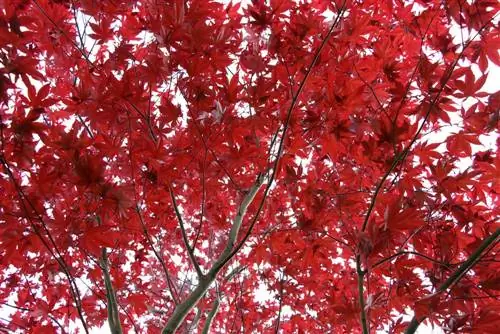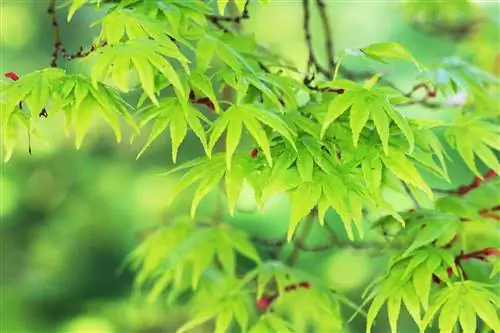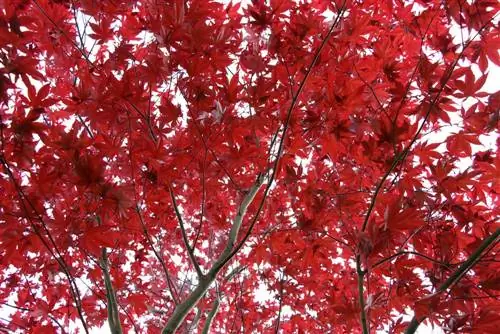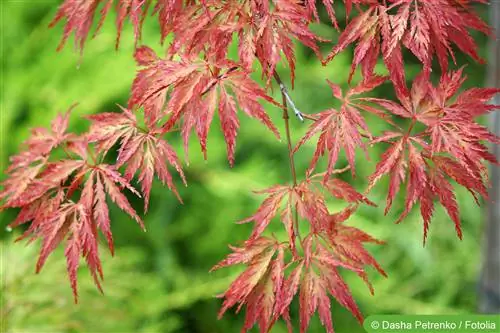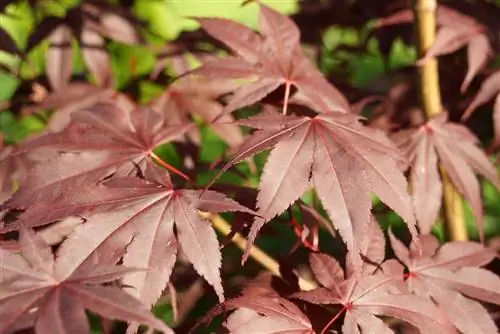- Author admin [email protected].
- Public 2023-12-17 03:39.
- Last modified 2025-01-24 12:45.
Japanese maple, which can be found in gardens in this country, is a comparatively small ornamental tree that grows very slowly. It may take a few years for it to reach full size. Pruning with the aim of curbing growth is not necessary here and can even be harmful. The small-growing species are prone to fungal infections such as mildew after pruning.
Does Japanese maple need pruning?
Japanese maple also usually grows evenly and forms an extremely compact and beautiful crown all by itself, without any external intervention. A topiary is almost unnecessary here. Quite the opposite: removing parts of the tree could even lead to gaps in the otherwise picturesque crown and thus disrupt the harmonious overall picture. At most, a slight topiary to maintain symmetry can be done carefully.
When is pruning unavoidable?
While Japanese maples generally do not require pruning, they may still need to be pruned over the course of their extremely long life.
A Japanese maple should or must be cut in the following cases:
- There are frozen and/or dead shoots on the tree
- Parts of the maple tree are affected by pathogens
- Other plants nearby are hindered from growing
Tip:
If you take your preferences into account when planting the maple and plan enough space for future growth, the Japanese maple can develop he althily and unhindered, making pruning unnecessary.
Sick wood can't wait
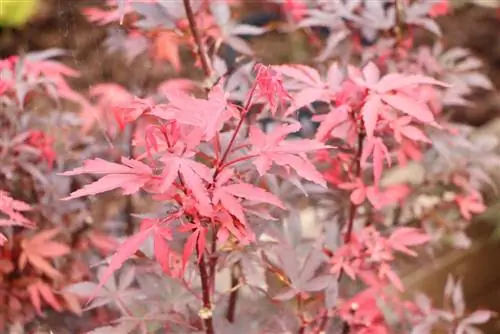
Sick wood should be removed as quickly as possible. If you wait too long, the disease can spread further and affect other he althy parts of the maple. The disease can eventually reach such an extent that the maple can no longer be saved. In particular, the dreaded verticillium wilt, which is caused by fungi in the soil, causes the branches to die quickly. Whether the red Japanese maple or a green variety is affected, rapid and drastic pruning is necessary in all cases.
So don't wait for the season that is particularly suitable for a cut. Whenever you discover infected branches, take immediate action. This will give the maple a better chance of survival.
Spring is the right time for dead shoots
When the temperatures are very low in winter, individual branches of the maple tree can freeze. In addition, the Japanese maple can suffer from branch dieback in early spring. In this case, you should remove the branches in spring as soon as the buds sprout. This way you don't disturb the new growth. Work carefully and only up to the living wood and not beyond.
Do not cut the branches close to the trunk, but be careful not to damage the branch collar. Since the sap flow began early in winter, no he althy shoots should be removed now. The risk of major fluid loss would be too high. Your Japanese maple can literally bleed. Of course, this does not apply to dead shoots, as there is no more juice in them.
Summer is more suitable for a topiary
A small Japanese maple does not require major pruning. For stronger growing species, a slight shape cut is possible, whereby shoot tips are shortened. In late summer, vegetation begins to go dormant, the sap pressure drops and thus the risk of fluid loss. Now is the right time to cut individual he althy branches and twigs in order to obtain the desired compact shape. Under no circumstances should you wait until autumn or even winter to do this, because the cut surfaces then heal poorly and are particularly susceptible to disease. How much of the branches you cut depends on the size of the maple bush and your wishes.
Tip:
Cutted shoots that are still completely he althy can be used as cuttings for propagation.
The weather of the day also plays a role
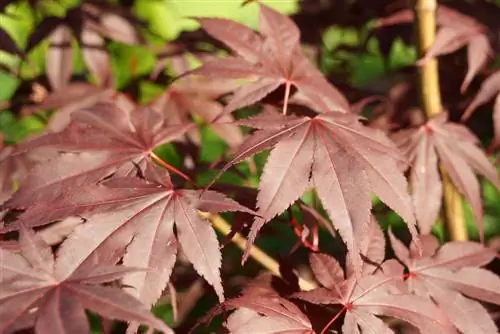
When is a good time to cut back the maple tree also depends on the weather of the day. Theoretically, the cut can be done in any weather, but it still makes sense to wait for a day that is particularly suitable from a weather perspective. Japanese maple is ideally pruned on a sunny, dry day. The fresh cuts heal faster in dry weather than on damp, cloudy or even rainy days. The risk of infection with unpleasant diseases is significantly reduced. An extremely important point that the Japanese maple is sometimes sensitive to. The faster his cuts heal, the more certain it is that he will forgive the regression and survive unscathed.
Step by step instructions for the right cut
Below you will find detailed instructions on how to carry out the proper cut step by step. Be sure to follow all the steps in the instructions in the given order so that the cut is successful and your maple is not damaged.
Step 1: Have the required tools ready
So that your Japanese maple survives the pruning well, only suitable tools should be used for all pruning measures. If you don't already have such a tool, you can get it early from well-stocked hardware stores and garden centers. The focus here should be on quality. You will need the following tools and materials in good time before your Japanese maple is to be cut back.
- Gardening shears for removing shoots and branches with a diameter of about 1.5 cm and thinner branches, as well as for removing old inflorescences.
- Pruning shears for cutting thinner branches with a diameter of up to 4 cm
- Saw for cutting thicker branches
- Dishwashing liquid for cleaning the tool
- Alcohol to disinfect the tool
- Water
- Cloths
- Tree wax for sealing larger interfaces from around 2 cm in diameter
- Brush for cleaning the interfaces and applying the sealant
Step 2: Sharpen, clean and disinfect cutting tool before use

Garden scissors and other cutting tools are used often, but over time they lose their sharpness until they become completely blunt. However, blunt tools lead to messy cuts and bruises on the plant. Cut wounds heal poorly and pathogens can penetrate more easily and damage the plant. Care should also be taken when using the same cutting tools to cut different plants, shrubs and trees. Pathogens, such as fungi, establish themselves where they can survive for a long time. During the next cut they will be transferred to other still he althy plants.
- Sharpen cutting tool blades if necessary
- Clean cutting tools thoroughly with water and detergent
- Wipe cutting blades with a cloth soaked in alcohol to disinfect them
- Also disinfect your hands as they may have come into contact with pathogens when cleaning the tool.
Note:
These precautions should not never be neglected, whether due to lack of time or other reasons.
Step 3: Determine what to cut away
Before you start the actual pruning, take enough time to take a closer look at the shrub or tree. Particularly if he althy shoots are to be planted, the cut must be planned precisely so that the crown retains its beautiful and harmonious appearance even after the cut. If necessary, mark the branches and twigs to be cut away.
Dead and diseased shoots must be removed in any case. He althy shoots should be carefully selected for symmetry.
Step 4: Make the cut
- If there are dead or diseased branches, remove them first.
- Separate the branches at the origin. However, make sure to make a vertical and clean cut without damaging the branch collar (=a short branch attachment point on the trunk)
- Pull out the cut branches carefully without damaging he althy branches.
Note:
If diseased branches have been cut off, the scissors must be disinfected again before further use.
Now, if necessary, cut off the he althy branches of a maple bush with garden shears or pruning shears. It is best to cut above a branch or a thumb's width above a bud
Note:
Don't cut into the old wood, only cut fresh/this year's wood. Only here do new shoots develop again.
- When pruning, the natural shape should be retained as much as possible, so cut branches that are evenly distributed across the bush.
- It is best to saw thick branches on large maple trees in several steps, otherwise the last part of the branch can tear off. First saw it off 10 cm from the trunk and then saw off the remaining stump even further. However, keep enough distance from the trunk to avoid damaging the branch collar.
Note:
Don't pull out even small branches. This can cause significant damage to the Japanese maple. Only use the cutting tool.
Step 5: Seal large cut surfaces
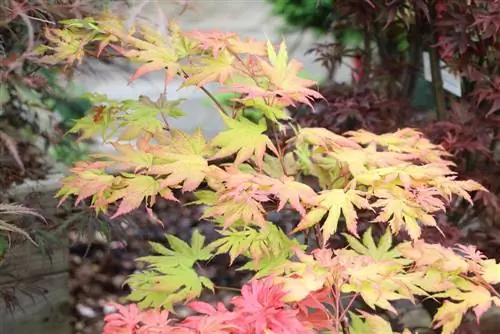
Cut surfaces are open wounds into which pathogens can penetrate and cause a fungal infection, for example. Cuts with a diameter of more than 1 cm should therefore be sealed with a suitable beeswax. Apply the beeswax with a brush, making sure not to miss any area, even a small one. Also follow the manufacturer's instructions on the beeswax packaging. The wax prevents so-called bleeding, when the tree loses a lot of its sap through open and unprotected interfaces.
Special feature: Japanese maple bonsai
If you have a Japanese maple bonsai, you need to keep it in shape with regular pruning - unlike a normal maple tree. It is best to carry out the topiary in autumn. Thinning, however, is possible all year round. Leaf trimming is required every other year, removing at least half of the leaves up to the stem.
Note:
Here too, all precautionary measures must be observed, from cleaning and disinfecting the cutting tool to sealing the wounds.

